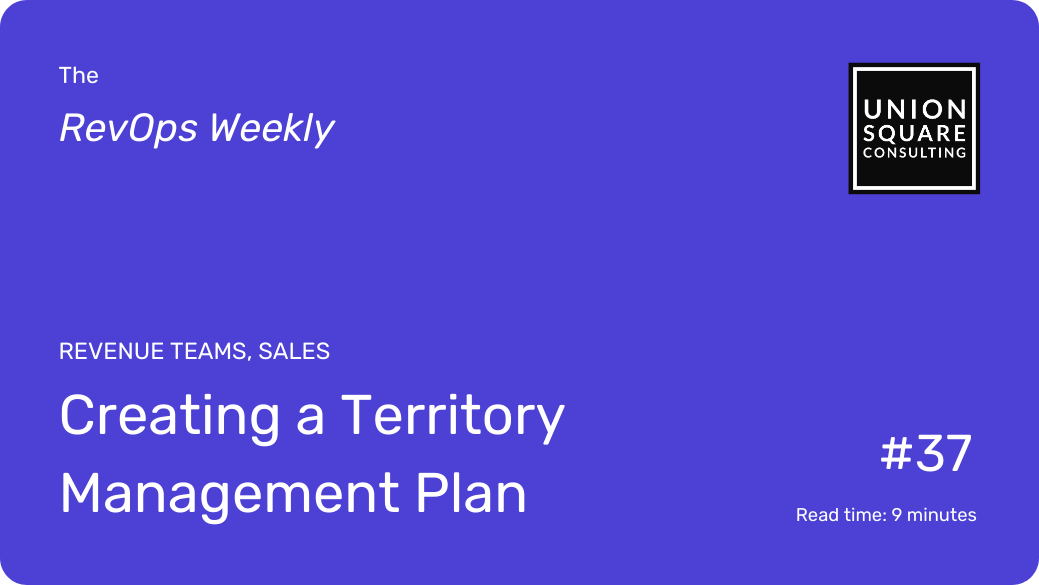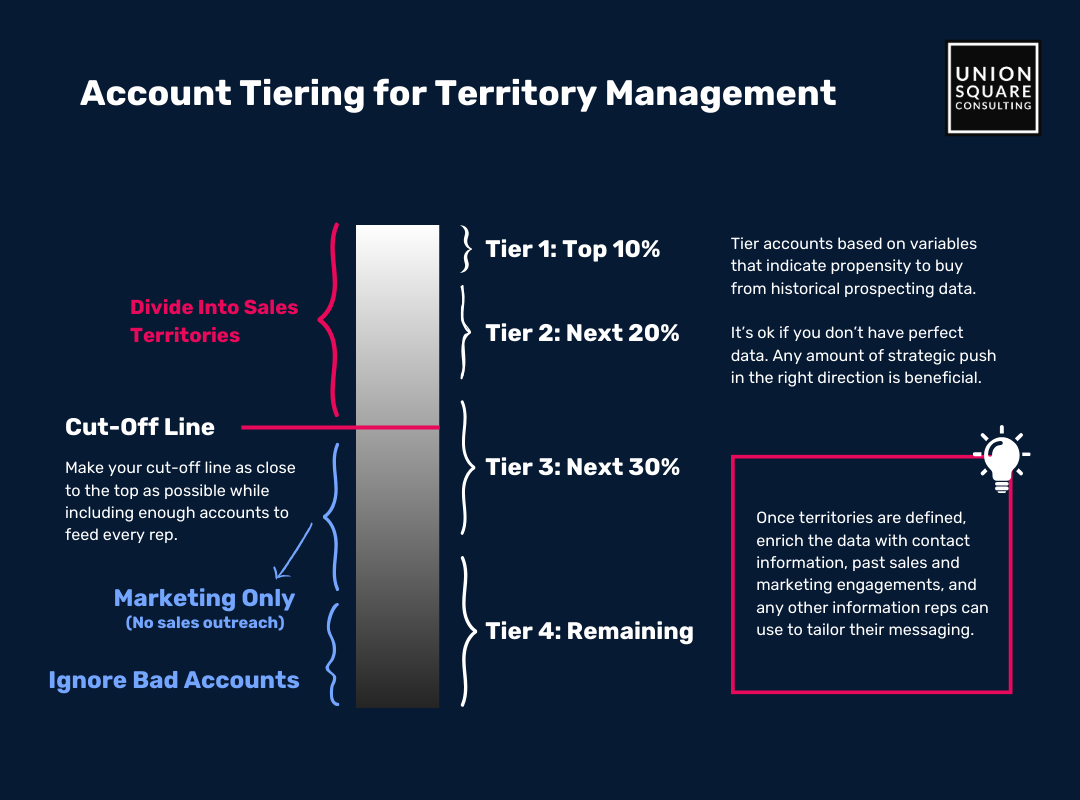
Creating a Territory Management Plan
Read time: 9 minutesThe success of a salesperson hinges on three things:
- Talent
- Timing
- Territory
All else equal, the quality of a salesperson’s territory can make or break them.
With a lack of territory planning, a lot of time ends up being wasted trying to find and connect with the right prospects. Even more time gets wasted focusing on the wrong prospects.
With non-strategic territory planning, some of your reps are over-capacity and unable to call all of their accounts while others don’t have enough territory to hit quota.
Both scenarios are bad for revenue, sales efficiency, and morale.
When it comes to emerging tech, out of all the spaces we’re monitoring, territory management seems to be moving the most. With AI, we’re going to see some big improvements with the quality of territory scoring, measurement, and organization in as little as the next few months.
Figuring out the proven methodology for territory planning now will not only give you short-term wins, but will prime you for what’s to come.
In this newsletter, we’ll show you how to:
- Set the tone with your Sales team
- Define variables that signal propensity to buy
- Tier accounts based on size of potential opportunity
- Balance the division of accounts among salespeople
Follow this approach to territory planning and you’ll see improvement in CAC almost immediately.
Set the Tone with Your Sales Team
As a RevOps team creating a territory plan, the first thing you want to do is dispel the idea that you’re dictating this plan to them as an order.
This is because you don’t want to:
- Disregard their boots-on-the-ground experience
- Lose their trust completely if there’s a mistake
A RevOps territory plan is a collaboration, not a command.
What we’re trying to do is remove the noise that is not likely to win and leave sales reps with better chances to close a larger volume of revenue.
In saying that, our data is never going to be 100% perfect. Things will slip through the cracks, especially at larger companies with a lot more data. If we treat our territory plan like an order, the moment a rep comes across a mistake, they’ll lose faith in the entire plan.
Get ahead of that by setting the tone beforehand, leading with value, and opening up communication.
Tell your sales team:
“We’re going to provide you with a list of really solid accounts. We’re going to enrich them for you, so you have validated data on people, phone numbers, email addresses, and more. But we know that you’re an expert in this, so we want you to take another pass at it and let us know if you find anything that looks funky. Let’s work on this together.”
This is the foundation for success with a territory plan.
Define Variables that Signal Propensity to Buy
Territory planning, at its core, is about scoring accounts and dividing them among reps based on that score.
Before you can do that, you need to:
- Identify data sources
- Define scoring criteria
You’ll want to continuously refine your scoring methodology based on feedback and new insights. Iterative improvement and validation is key here – the quality of your data dictates the effectiveness of your plan.
Step 1: Identify Data Sources
If you’re a large company, you’ll be scoring accounts based on historical sales data.
If you’re a smaller company, you don’t have a robust data set to draw from to define scoring criteria. When your blocker is market data, you need some method for expanding your database.
This can come in a lot of different forms. The worst form, which I advise you to never do, is buy a list from a random vendor. Your duplicates will appear by the hundreds overnight and it will be a mess. Instead, buy access to reputable sources of data such as Zoominfo, Apollo, Lusha, Ebsta, etc.
Another simple method is to go out and talk to people. Network, put out surveys, have interviews with your ICP. Learn what people are looking for and then try to find companies that align with this.
Step 2: Define Scoring Criteria
Your scoring criteria is going to be based on variables that matter to your company, specifically.
This might include region, company size, the tech they use, or other unique factors that make you a better fit for your customers than the competition.
Cross-reference your data sources with other proprietary data or toolsets. Ask your sales team about signals they’ve noticed that indicate a propensity to buy during the prospecting stage.
Once you have a list of variables to look for, you can start scoring accounts against them.
Tier Your Accounts, then Tier Them Again
Once you score your accounts, you’ll see the creme de la creme rise to the top that show every single signal of a high-value prospect. The rest will fall somewhere in between “most signals” and “none”.
If you have the data for it, you can get even more sophisticated. Analyzing likelihood to buy through the lens of what they might buy, or how much, makes the value of the opportunity even clearer.
It can be as simple as multiplying their score by how much you expect them to buy, and using the resulting number (rather than the score alone) to tier them.
For example, if you’re scoring accounts out of 100 and an account has a score of 90 but they’re likely to spend $10k, the expected value of the account is $9k. If another account has a score of 70 but they’re likely to spend $20k, their expected value is $14k.
Keep in mind, you need a LOT of data to get this granular. It’s ok if you’re not there yet. Any amount of pushing your salespeople in the right direction is going to be beneficial, so just do what you can.
For tiering, there’s no cutoff that indicates which accounts are good and which are bad. Instead, it’s more of a gray gradient of potential.
Tier 1: Top 10%
Tier 2: Next 20%
Tier 3: Next 30%
Tier 4: Remaining
Your goal is to find the spot as close to the top as you can, while still having enough accounts for every rep’s territory, and draw your line there. All of the accounts below that line you can tell your sales team not to worry about. You want them to put all of their focus above the line and have Marketing work on the rest.
(For accounts that are absolutely not a good fit, disregard them completely.)
This is the point where the collaboration with Sales comes in.
After you’ve assigned them their territories from the accounts above the line, ask your sales people to organize their own personal tiers based on their experience in this space. (Keep in mind that this doesn’t mean they should be haggling for different accounts.)
They can fluidly update these tiers as they visit websites, read news, and speak to people in these accounts.
They can choose who to prioritize – but you’ve given them a massive leg up.
Balance the Division of Accounts Among Salespeople
When you’re figuring out how many accounts someone should have, it’s not so much a question of account value as it is capacity.
How many accounts can someone handle? And by that I mean, conducting a proper outbound process with each one.
This capacity will change depending on whether you’re targeting enterprise, mid, or small businesses. Teams working massive, multinational accounts might only have a capacity of 5, while teams working much smaller companies might have a capacity of 100. They should all have roughly the same opportunity value within their tier and geography.
Read our newsletter on capacity planning to learn more.
Once you’ve divided territories based on tier, deal size, and capacity, the next step is to add relevant contact info. You can use tools like ZoomInfo to identify contacts in your Buyer Persona(s) within each account and add titles, email, phone, LinkedIn and/or other socials.
You should also include one-click access to the website, past sales and marketing engagements, and any other information reps can use to tailor their messaging.
The goal here is to make it lightning-fast for reps to research contacts and then reach out with relevant messaging.
Final Word
Your territory plan will need continuous iteration and additions as things move. Any accounts that aren’t assigned to a rep (especially tier 1 and 2) are fair game for Marketing. If they’re absolutely not a fit, Marketing shouldn’t bother either.
And there you have it! You’ve just increased your sales team’s efficiency by 70% or more. If you need help building your territory plan, we offer this as part of our Strategic RevOps services.
TL;DR
- Poor territory planning hurts revenue, sales efficiency, and morale
- To create a territory plan, first set the tone with your sales team
- A RevOps territory plan is a collaboration, not a command
- Your data will never be 100% perfect, prepare for mistakes
- Tell Sales that you will provide a list of verified, enriched accounts
- Next, define variables that signal propensity to buy:
- Identify your data sources
- Define scoring criteria
- Tier your accounts
- Put the top 10% accounts in tier 1
- The next 20% in tier 2
- The next 30% in tier 3
- The rest in tier 4
- Make your cutoff point as close to the top as you can
- While still having enough accounts for all your reps
- Divide accounts among your salespeople
- Understand the capacity of your reps
- Divide territories based on tier, deal size, and capacity
- Enrich the account data with Buyer Persona contact info
- Ask your reps to tier within their own territory based on their expertise
- Your territory plan will need constant iteration and additions
- All unassigned accounts should be worked on by marketing
- Accounts that are not a good fit should be disregarded altogether
When you’re ready, here’s how we can help:
Get a Free 1:1 Revenue Efficiency Workshop
Get one of our Senior Revenue Strategists to yourself for 1 hour and leave with a plan to increase the money-making power of your go-to-market operations.
Hire Us!
Bring us on as your Strategic RevOps Team and realize the growth potential of your revenue engine. There are 3 ways to work with us.
Get more tips like these, sent right to your inbox.
Subscribe for fresh, relevant revenue growth tips delivered every week.
